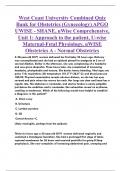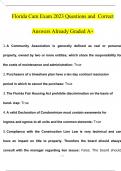West Coast University Combined Quiz
Bank for Obstetrics (Gynecology) APGO
UWISE - SHANE, uWise Comprehensive,
Unit 1: Approach to the patient, U-wise
Maternal-Fetal Physiology, uWISE
Obstetrics A - Normal Obstetrics
A 20-year-old G1P1 woman delivered her first baby 24 hours ago. Delivery
was uncomplicated and she had an epidural placed for analgesia at 5 cm of
cervical dilation. Earlier in the afternoon, she was complaining of a headache
and was given ibuprofen. Three hours later, she complained of increasing
headache, photophobia and nausea. She denies heavy bleeding. Vital signs are
pulse 110; respirations 20; temperature 101.5° F (38.6° C); and blood pressure
100/50. Physical examination reveals obvious distress, as she has her eyes
covered and pain when she moves her neck. Her lungs are clear and heart has a
regular rate. Her abdomen is nontender, and uterine fundus is easily palpable
just below the umbilicus and is nontender. Her extremities reveal no erythema,
swelling or tenderness. Which of the following would most helpful to establish
a diagnosis in this patient?
A. Chest x-ray
B. Urinalysis
C. Lumbar puncture
D. CB
Correct Answer -C.
Likely meningitis, perhaps from the epidural.
Thirty-six hours ago a 23-year-old G1P1 woman delivered vaginally and
sustained a 2nd-degree laceration. She had a prolonged first stage of labor,
ruptured membranes for 26 hours and received penicillin for group B Strep
prophylaxis. She now complains of increasing abdominal pain, cramping and
,heavy, foul-smelling lochia. Her vital signs reveal a temperature of 100.0° F
(37.8° C); pulse 80; blood pressure 120/60; and respirations 18. She has a
tender uterine fundus that measures at the umbilicus. Her extremities reveal
mild bilateral edema; no erythema or tenderness. Blood work reveals a white
count of 12.2; hematocrit of 34%; and normal chemistries. Her urinalysis is
positive for blood and negative for WBCs, leukocyte esterase and nitrites. In
addition to ampicillin, which of the following would be the best antibiotic
choice?
A. Erythromycin
B. Gentamicin
C. Doxycycline
D. Vancomycin
E. Ciprofloxacin
Correct Answer -B. Endomyometritis is a common complication of prolonged
labor, prolonged rupture of membranes and multiple vaginal examinations. The
infection is polymicrobial, mostly anaerobic and requires broad-spectrum
antibiotics for treatment until the patient is afebrile for 24 hours. By adding
Gentamicin, you are covering the spectrum of gram-negative organisms.
Erythromycin provides good coverage for upper respiratory infections.
Vancomycin provides good coverage for S. aureus and penicillin-resistant gram-
positive bacteria. Ciprofloxacin provides excellent coverage for gram-negative
pathogens, including Pseudomonas.
A 23-year-old G1P1 woman delivered vaginally at 42-weeks gestation after a
prolonged induction of labor. She had an epidural with an indwelling catheter
for 36 hours and three IV sites for her intravenous medications. She now
complains of lower abdominal pain, frequency and dysuria. Her vital signs are:
temperature 98.6° F (37° C); pulse 70; blood pressure 100/60; and respirations
12. On examination, her lungs are clear, cardiac exam is normal, abdomen is
soft, uterine fundus is firm and nontender, and she has mild suprapubic
tenderness. Which of the following organisms is most likely causing her
discomfort?
A. Group A streptococcus
,B. Proteus mirabilis
C. Klebsiella pneumoniae
D. Escherichia coli
E. Group B Streptococcus
Correct Answer -D. Acute cystitis is a common complication after vaginal
delivery and the risk increases with the use of an indwelling catheter. The most
common cause of acute cystitis infection is gram-negative bacteria. The major
pathogens are E. coli (75%), P. mirabilis (8%), K. pneumoniae (20%), S.
faecalis (<5%), and S. agalactiae.
A 23-year-old G1P1 woman delivered her first baby two days ago after an
uncomplicated labor and vaginal delivery. She wants to breastfeed and has
been working with the lactation team. Prior to discharge, her temperature was
100.4° F (38° C) and other vitals were normal. She denies urinary frequency or
dysuria and her lochia is mild without odor. On examination, her lungs are
clear, cardiac exam normal, and abdomen and uterine fundus are nontender.
Her breasts are firm and tender throughout, without erythema, and nipples are
intact. Which of the following is the most likely cause of her fever?
A. Endomyometritis
B. Septic pelvic thrombophlebitis
C. Mastitis
D. Breast engorgement
E. Vaginitis
Correct Answer -D. Breast engorgement is an exaggerated response to the
lymphatic and venous congestion associated with lactation. Milk "let-down"
generally occurs on postpartum day two or three. If the baby is not feeding
well, the breast can become engorged, which can cause a low-grade fever.
Lactating women are encouraged to feed their baby frequently, and use a breast
pump to prevent painful engorgement and mastitis. Postpartum fever
differential includes endometritis, cystitis and mastitis. These are easy
distinguished, based on clinical findings. Vaginitis is not accompanied by fever.
Septic pelvic thrombophlebitis is a rare condition and characterized by high
fever not responsive to antibiotics and is a diagnosis of exclusion.
, A 23-year-old G1P1 woman is five days post-operative from a Cesarean section
for arrest of labor at 7 cm. She now complains of minimal abdominal pain and
drainage from the right side of the incision. Lochia is normal and she has no
urinary complaints. Her vital signs are normal and she is afebrile. On physical
exam, her lung and cardiac examinations are normal. Her abdomen and uterine
fundus are nontender. Her Pfannenstiel incision has tenderness extending 3 cm
from the incision and there is serous, bloody drainage coming from the right
side. What is the next best step in the management of this patient?
A. Initiate intravenous antibiotics
B. Initiate oral antibiotics
C. Occlusive dressing to the wound
D. Open drainage of wound
E. Tropical antibiotics to the wound
Correct Answer -D. Mixed bacteria originating from the skin, uterus and vagina
cause wound infections after a Cesarean section. Prior to establishing a
diagnosis of surgical site infection, evaluation requires opening the wound,
checking for fascial dehiscence, drainage and assessment of the fluid. Packing
the wound until it has healed from the base of the wound facilitates the healing
process. Broad spectrum antibiotics are indicated if you suspect cellulitis or
abscess.
A 32-year-old G2P2 woman delivered five days ago by uncomplicated vaginal
delivery. Her postpartum course thus far has been unremarkable and she is
breastfeeding without difficulty. She woke up in the middle of the night with
intense upper abdominal pain and chills. She admits that she has had pain like
this before, but never this severe. Her vital signs reveal blood pressure 120/70;
pulse 110; and temperature 101.8° F (38.8° C). On physical examination, she
has abdominal pain located in the right upper quadrant with rebound
tenderness. Her uterine fundus is well below the umbilicus and nontender. Her
lochia is normal. Laboratory tests reveal mild anemia, a slightly elevated white






